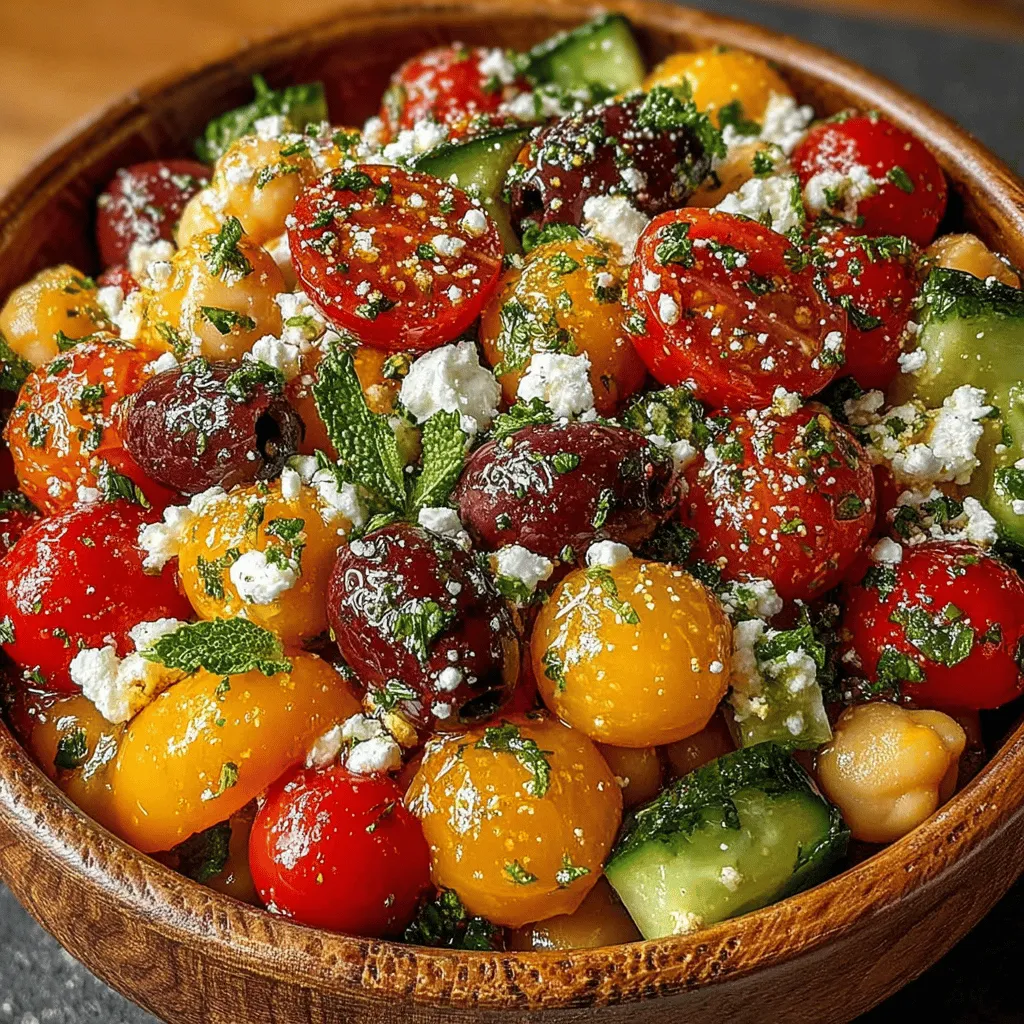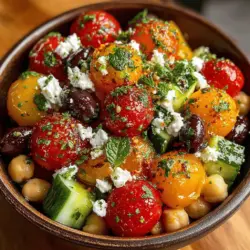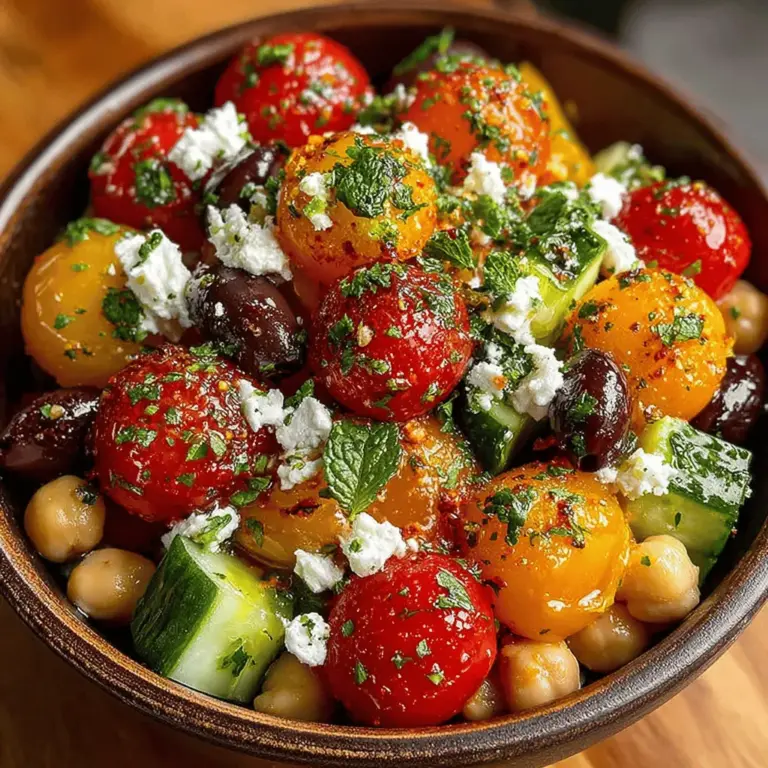Introduction to Mediterranean Chickpea Salad Bowls
In today’s health-conscious world, salads have transcended their traditional role as mere side dishes, evolving into vibrant and satisfying meals that cater to diverse palates and dietary preferences. Among the myriad of salad options, Mediterranean Chickpea Salad Bowls stand out as a quintessential representation of this culinary evolution. This dish not only embodies the freshness and variety of Mediterranean cuisine but also packs a nutritious punch with its combination of protein-rich chickpeas, colorful vegetables, and a harmony of flavors brought to life by herbs and feta cheese.
Mediterranean cuisine, known for its emphasis on fresh ingredients and balanced flavors, has influenced food cultures worldwide. The Mediterranean Chickpea Salad Bowls are a testament to this legacy, showcasing how simple ingredients can be transformed into a delightful meal that is both wholesome and flavorful. In this article, we will delve into the origins of this beloved dish, highlight the nutritional benefits of its key components, and provide a step-by-step guide to assembling your own Mediterranean Chickpea Salad Bowls at home.
The Origins of Mediterranean Cuisine
Mediterranean cuisine is characterized by its diverse ingredients and cooking techniques that have evolved over centuries, influenced by the various cultures that inhabit the region. From Greece and Italy to Morocco and Lebanon, each country contributes unique flavors and traditions, creating a rich tapestry of culinary practices. The Mediterranean diet, in particular, is recognized for its health benefits, emphasizing fruits, vegetables, whole grains, legumes, nuts, and healthy fats, especially olive oil.
Key ingredients commonly found in Mediterranean recipes include an array of vegetables, legumes, seafood, and grains. Staples such as tomatoes, cucumbers, eggplants, and bell peppers provide not only vibrant colors but also essential nutrients. Legumes like chickpeas and lentils serve as vital sources of protein, particularly in vegetarian diets. Additionally, the use of fresh herbs like parsley, basil, and mint elevates dishes, enhancing both flavor and nutritional value.
The influence of Mediterranean cuisine has spread far beyond its geographic boundaries, shaping global food trends that prioritize fresh, wholesome ingredients. The rise of plant-based diets, for example, can be largely attributed to the popularity of Mediterranean dishes that celebrate legumes and vegetables. As more people seek healthy eating options, the Mediterranean Chickpea Salad Bowls have emerged as a go-to meal, combining convenience, nutrition, and taste.
Nutritional Benefits of Chickpeas
Chickpeas, the star ingredient in Mediterranean Chickpea Salad Bowls, are not only versatile but also nutritionally rich. One of the most significant benefits of chickpeas is their high protein content, making them an excellent choice for vegetarians and vegans who may struggle to meet their protein needs. With approximately 15 grams of protein per cooked cup, chickpeas help support muscle growth and repair, making them an essential component of a balanced diet.
In addition to protein, chickpeas are an excellent source of dietary fiber, which plays a crucial role in digestive health. A single serving of chickpeas can provide nearly half of the recommended daily intake of fiber, promoting regular bowel movements and helping to maintain a healthy digestive system. Moreover, fiber is known to help regulate blood sugar levels, making chickpeas a smart choice for those managing diabetes or looking to maintain stable energy levels throughout the day.
Chickpeas are also packed with essential vitamins and minerals, including iron, folate, and magnesium. Iron is vital for oxygen transport in the body, while folate is important for cell division and overall health. Magnesium plays a role in many bodily functions, including energy production and muscle function. By incorporating chickpeas into your diet, you can reap these nutritional benefits while enjoying a delicious and satisfying meal.
Fresh Vegetables: A Key Component
The freshness of the vegetables used in Mediterranean Chickpea Salad Bowls is what truly brings this dish to life. Each vegetable not only contributes a unique flavor but also adds a variety of health benefits. Tomatoes, for instance, are rich in lycopene, an antioxidant linked to numerous health benefits, including reduced risk of chronic diseases. They provide hydration due to their high water content, making them a refreshing addition to the salad.
Cucumbers are another staple in this vibrant bowl, known for their crisp texture and low-calorie count. They are an excellent source of vitamins K and C, as well as potassium. The high water content in cucumbers also aids in hydration and contributes to overall well-being. When combined with chickpeas, these vegetables not only enhance the nutritional profile of the dish but also add a refreshing crunch.
Bell peppers and red onions further elevate the flavor and nutritional content of the salad. Bell peppers are rich in vitamins A and C, which are important for immune function and skin health. Their sweetness pairs well with the earthiness of the chickpeas. Red onions, on the other hand, offer a sharp flavor that balances the dish, along with antioxidant properties that can support heart health.
Lastly, olives play a significant role in Mediterranean diets. These small fruits are loaded with monounsaturated fats, which are beneficial for heart health. Olives also provide a savory, briny flavor that complements the other ingredients, tying the salad together and enhancing its overall taste.
The Role of Feta Cheese in the Salad
Feta cheese is an iconic component of Mediterranean cuisine, and its inclusion in Chickpea Salad Bowls adds both flavor and texture. Known for its crumbly texture and tangy taste, feta cheese enhances the overall flavor profile of the dish, providing a creamy contrast to the crisp vegetables and hearty chickpeas.
From a nutritional standpoint, feta cheese is lower in calories and fat compared to many other cheese varieties, making it a favorable option for those looking to maintain a balanced diet. A typical serving of feta cheese offers a good source of calcium, which is essential for strong bones and teeth. Additionally, its probiotic content can contribute to gut health, further enhancing the overall health benefits of the salad.
One of the defining characteristics of feta cheese is its unique flavor, which varies depending on the milk used and the aging process. Made from sheep’s milk, goat’s milk, or a combination of both, feta cheese brings a distinct tanginess that elevates dishes and adds depth to the flavor of the salad. In contrast to other cheese varieties, such as cheddar or mozzarella, feta’s crumbly texture and bold taste make it an ideal choice for salads, providing a delightful burst of flavor with every bite.
Herbs: Elevating Flavor and Nutrition
No Mediterranean dish would be complete without the addition of fresh herbs, which not only elevate the flavor but also contribute significant nutritional benefits. In Mediterranean Chickpea Salad Bowls, parsley and mint are the most commonly used herbs, each offering a unique taste and aroma that enhances the overall dish.
Fresh parsley is a powerhouse of nutrients, rich in vitamins A, C, and K, as well as antioxidants that can help combat inflammation and support overall health. Its bright flavor complements the other ingredients in the salad, adding a fresh and vibrant note. Parsley is also known for its digestive benefits, aiding in the breakdown of food and promoting a healthy gut.
Mint, on the other hand, brings a refreshing element to the salad, invigorating the palate with its cool flavor. This aromatic herb has been used for centuries for its medicinal properties, including its ability to soothe digestive issues and relieve headaches. In addition to its health benefits, mint adds a delightful aroma that enhances the overall sensory experience of the dish.
Incorporating fresh herbs not only amplifies the flavors but also boosts the nutritional content of Mediterranean Chickpea Salad Bowls, making them a wholesome and satisfying meal option. As we move forward in this article, we will outline the step-by-step process of creating these vibrant salad bowls, ensuring that you can enjoy the rich flavors and health benefits of this Mediterranean classic right in your own home.

How Herbs Contribute to Overall Health
Herbs play a pivotal role not only in enhancing the flavor of dishes but also in contributing to overall health. Rich in antioxidants and essential nutrients, herbs such as parsley, basil, and cilantro can boost the immune system, reduce inflammation, and improve digestion. For instance, parsley is a fantastic source of vitamins A, C, and K, which are crucial for maintaining healthy skin, vision, and bone health. Incorporating fresh herbs into your Mediterranean Chickpea Salad Bowls not only elevates the taste but also enriches your meal with health benefits, making it a powerhouse of nutrition.
Tips for Using Herbs in Salads
1. Choose Fresh Over Dried: Fresh herbs have a more vibrant flavor and aroma compared to dried herbs. Whenever possible, opt for fresh varieties for your salads.
2. Chop Just Before Use: To preserve their essential oils and flavor, chop herbs just before adding them to your salad.
3. Experiment with Combinations: Don’t hesitate to mix different herbs to create complex flavors. For example, combining mint with parsley can provide a refreshing twist.
4. Use Whole Leaves for Garnishing: Whole leaves can add a beautiful touch to your salad. Scatter them on top just before serving for an appealing presentation.
5. Incorporate Herbs into Dressings: Blend fresh herbs with your dressing for an added flavor boost. This method allows the herbs to infuse their natural oils into the dressing, enhancing the overall taste of the salad.
Step-by-Step Guide to Making Mediterranean Chickpea Salad Bowls
Preparing the Vegetables
To start creating your Mediterranean Chickpea Salad Bowls, the first step is to prepare the vegetables. Fresh, high-quality ingredients are crucial for achieving the best flavor and texture in your salad.
Importance of Using Fresh and High-Quality Ingredients
Fresh vegetables not only taste better but also retain more nutrients. When selecting your ingredients, look for vibrant colors, firm textures, and avoid any that appear wilted or spoiled. Local farmers’ markets are often a great source of fresh produce.
Tips for Dicing and Chopping for Uniformity
Uniformly diced vegetables not only ensure even flavor distribution but also enhance the visual appeal of your salad. Here are some tips for achieving uniformity:
– Use a Sharp Knife: A sharp knife makes cleaner cuts, which helps maintain the integrity of the vegetables.
– Cut in Batches: Work through your vegetables in batches, starting with larger items and moving to smaller ones.
– Consistent Sizes: Aim for pieces that are about the same size—this helps them cook evenly if you’re planning to roast or sauté them.
Making the Dressing
A delicious dressing is the heart of your Mediterranean Chickpea Salad, elevating the flavors of the fresh ingredients.
Ingredients Needed for the Dressing
For the perfect dressing, you will need the following ingredients:
– 1/4 cup of extra virgin olive oil
– 2 tablespoons of fresh lemon juice
– 1 teaspoon of Dijon mustard
– 1 clove of garlic, minced
– Salt and pepper to taste
– Optional: A teaspoon of honey or maple syrup for sweetness
The Significance of Olive Oil and Lemon Juice
Extra virgin olive oil is a staple of the Mediterranean diet, packed with healthy fats that are essential for heart health. Meanwhile, lemon juice adds a tangy brightness that complements the earthy flavors of chickpeas and vegetables. This combination not only enhances taste but also offers numerous health benefits, including anti-inflammatory properties.
Combining Ingredients for Maximum Flavor
Once your vegetables are prepped and the dressing is ready, it’s time to combine everything for maximum flavor.
Techniques for Tossing Without Breaking the Feta
If you’re adding feta cheese to your salad, be gentle when tossing the ingredients. Use a large spoon or spatula, and fold the ingredients rather than tossing them vigorously. This will prevent the feta from crumbling too much and help maintain its creamy texture throughout the salad.
Importance of Tasting and Adjusting Seasoning
Tasting your salad before serving is crucial. Adjust the seasoning by adding more salt, pepper, or lemon juice as needed. This final touch ensures that all the flavors meld beautifully, creating a deliciously balanced dish.
Serving Suggestions
The presentation of your Mediterranean Chickpea Salad Bowls can enhance the dining experience. Here are some ideas:
1. Layered Presentation: Start with a base of greens such as arugula or spinach, add your chickpea mixture, and top with feta and herbs. This layered approach not only looks appealing but also allows diners to mix the salad as they wish.
2. In Individual Bowls: Serve the salad in individual bowls for a more personal touch. This method makes it easy for guests to add their desired toppings.
3. Chill Before Serving: If time allows, chill the salad in the refrigerator for about 30 minutes before serving. This helps the flavors meld together, resulting in a more flavorful dish.
Variations on the Mediterranean Chickpea Salad
One of the best aspects of the Mediterranean Chickpea Salad is its versatility. Here are some variations to customize your salad:
Incorporating Seasonal Vegetables
Take advantage of seasonal vegetables to keep your salad fresh and exciting. In the summer, consider adding diced cucumbers and bell peppers, while in the fall, roasted butternut squash or Brussels sprouts can add warmth and depth.
Protein Additions: Grilled Chicken or Shrimp
For those looking to increase protein intake, grilled chicken or shrimp can be fantastic additions. Simply marinate your protein in olive oil, lemon juice, and herbs before grilling and tossing it into the salad.
Vegan Alternatives for Feta Cheese
If you’re looking to keep your salad vegan, consider using alternatives to feta cheese. Crumbled tofu or vegan cheese can mimic the texture and flavor, or you could simply omit the cheese altogether and add extra nuts or seeds for crunch.
Conclusion: Embracing the Mediterranean Lifestyle through Food
The Mediterranean Chickpea Salad Bowls offer a delightful mix of flavors, colors, and textures that make them a perfect meal for any occasion. By understanding the nutritional benefits of each ingredient and following the simple steps outlined in this article, you can create a dish that not only satisfies your taste buds but also nourishes your body. Embrace the Mediterranean lifestyle by making this salad a staple in your meal rotation, enjoying the vibrant flavors and health benefits it has to offer.
Incorporating this flavorful salad into your weekly meals is a step toward a healthier diet. Not only will you enjoy the taste of fresh ingredients, but you will also benefit from the numerous health advantages that come with the Mediterranean way of eating. So gather your ingredients, follow the steps, and indulge in a delicious Mediterranean experience that promotes both wellness and culinary enjoyment.


